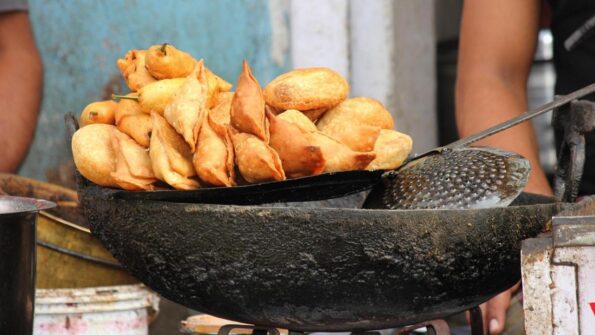Are samosas healthy? Mumbai health experts give you a reality check

Indian snacks are delicious, if not mouthwatering, and that is what makes them irresistible, especially the classic vada or samosa pav in Mumbai that have become synonymous with street food here. While the vada pav is a guarded treasure in the Maximum City, samosas have been in the news in the last few weeks. In July, it was about the apparent need for health labels on the Indian fried snack apart from jalebi, to promote healthy choices by highlighting the risks, and this week, Ravi Kishan brought up the samosa, along with dal tadka, during the zero hour of the Monsoon Session in the Lok Sabha.
The BJP MP and actor highlighted the samosa prices and portion size, and the unique need for uniformity across India. With the samosa in the spotlight again, the snack’s contents and health benefits are constantly looming large above our heads. It is not only at the governance level but also looked down upon in fitness circles. To put it to rest, mid-day spoke to health experts to understand if the samosa passes the ‘health’ check.
Health benefits and nutrition
Gulnaaz Shaikh, chief dietitian at KIMS Hospitals in Thane, says, “Traditional samosas are not considered particularly healthy. While they do contain some nutrients from the potato and pea filling—like fibre, vitamin C, and a small amount of protein—the health downsides outweigh the benefits.” This is because the outer crust is usually made from refined flour (maida), she highlights, which is low in nutritional value, and they’re deep-fried in oil, making them high in saturated fat and calories.
Sonal Chandalia, consultant nutritionist, Jaslok Hospital and Research Centre, highlights that when they are deep-fried, the process generates trans-fats, and samosas also tend to be reasonably high in salt. “The potato-filling classifies as a starch-based ingredient in samosas, which are considered to be calorie-dense junk food, so a poor source of vitamins and minerals,” she adds.
A medium-sized potato samosa, explains Shaikh, which is about 100–120 grams, typically contains 250 to 300 calories, with 15 to 20 grams of fat, largely due to deep frying. It also contains 25 to 35 grams of carbohydrates, 3 to 5 grams of protein, 2 to 3 grams of dietary fibre, and varying amounts of sodium depending on the seasoning used. These values may change based on the size, filling, and method of preparation.
While the contents of samosas are clear, how can they affect one’s health? Shaikh sheds light, “Regular consumption can contribute to weight gain, high cholesterol, and other health issues if not balanced with a nutritious diet.” Jinal Patel, dietitian at Zynova Shalby Hospital, says it can also spike blood sugar levels and cause heart issues, apart from digestive issues such as bloating, acidity, and constipation. “It`s best to avoid them and adhere to healthy eating practices. Even if you wish to eat it, it can be eaten once in five-six months,” the city-based health expert adds, while firmly believing in avoiding the snack altogether.
Innovate with your samosa recipes
However, even as it seems all is lost, and people need to stop consuming samosas, there is still hope. Patel says samosas can be made healthier with a few changes. She suggests, “Instead of deep-frying, you can bake or air-fry them to reduce oil and fat content. Use whole wheat flour instead of refined maida for the outer layer. For the filling, replace regular potatoes with sweet potatoes, sprouts, paneer, or mixed vegetables like peas, carrots, and spinach to make it healthy.” The Mumbai expert says you can also add spices like turmeric and cumin, which have health benefits.
It is not only Patel but also Suvarna Sawant, the chief dietician and HoD, Clinical Nutrition and Dietetics at Nanavati Max Super Speciality Hospital, Mumbai, who says you can innovate with it. Using seasonal ingredients and other tweaks, she explains, “Using whole wheat or millet flour for the crust instead of maida can add fibre and support your gut health. There are several nutritious alternatives for filling, like using methi in winter along with peas and sweet potatoes, or lauki and spinach in summer. These ingredients can offer necessary vitamins, minerals, and hydration, well suited to the season.”
For spices, she says, along with turmeric, you can also use ajwain, both of which will enhance the flavour and also support digestion. Lastly, she adds, “One doesn’t need to skip the samosas, just make them healthy enough to turn them from a guilty pleasure to a nourishing snack at home.”
Adding to the variety of options, Chandalia says, while you can also add cabbage to the peas-sweet potatoes mix, adding a sprinkle of skimmed paneer will give it a unique touch that can be spiced up with other masalas with just a dash of salt.
On the other hand, Shaikh says you can also add lentils or soya to the mix, improving the overall nutritional profile. Along with anti-inflammatory spices like turmeric and cumin, she says adding ginger can also offer added health benefits. For those seeking alternatives, options like baked vegetable patties, multigrain wraps with healthy fillings, steamed vegetable or chicken momos, and roasted chana or sprouts chaat can be satisfying yet much healthier than the traditional samosa, she adds.
“Samosa is an integral part of our cultural experience. It can become a nutritious, power-packed snack and be enjoyed during festivals as a starter. The key lies in healthy ingredients, cooking methods and portion control,” Chandalia concludes.
Search
Recent
- Watch: Rainfall brings Patna to standstill; waterlogging triggers traffic jams
- A ‘Dagger in the Heart’ of Climate Change Regulation
- What’s a Potato? A Nine-Million-Year-Old Tomato
- Candidate Trump Promised Oil Executives a Windfall. Now, They’re Getting It.
- Trump Taps Climate Skeptics to Attack Science on Global Warming





